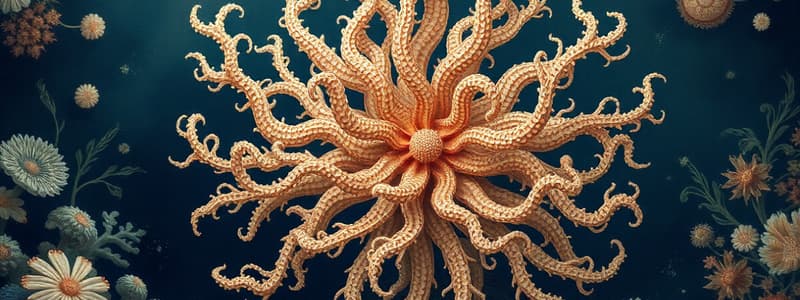Podcast
Questions and Answers
What characteristic distinguishes invertebrates from vertebrates?
What characteristic distinguishes invertebrates from vertebrates?
- Ability to reproduce sexually
- Absence of a backbone (correct)
- Presence of a complex nervous system
- Existence in a terrestrial habitat
What survival adaptation do sponges have that contributes to their longevity?
What survival adaptation do sponges have that contributes to their longevity?
- Development of hard shells
- Capacity to thrive in hostile environments (correct)
- Formation into colonies
- Ability to reproduce quickly
Which method can sponges use to reproduce?
Which method can sponges use to reproduce?
- Budding only
- Fission only
- Asexual reproduction through regeneration (correct)
- Only sexual reproduction
What do most cnidarians primarily feed on?
What do most cnidarians primarily feed on?
How long can some sponges potentially live?
How long can some sponges potentially live?
Which of the following is NOT a member of the cnidarian phylum?
Which of the following is NOT a member of the cnidarian phylum?
What ancient period do some sponge fossils predate?
What ancient period do some sponge fossils predate?
Why are sponges sometimes used in household cleaning today?
Why are sponges sometimes used in household cleaning today?
Which of the following statements is true about sponges?
Which of the following statements is true about sponges?
What typically characterizes the body structure of sponges?
What typically characterizes the body structure of sponges?
What is a significant reason why sponges can thrive in hostile environments?
What is a significant reason why sponges can thrive in hostile environments?
Which of the following best describes the body structure of sponges?
Which of the following best describes the body structure of sponges?
How do cnidarians primarily acquire their food?
How do cnidarians primarily acquire their food?
What unique ability allows sponges to reproduce without a mate?
What unique ability allows sponges to reproduce without a mate?
Which statement about sponges is true?
Which statement about sponges is true?
Which of the following describes cnidarians?
Which of the following describes cnidarians?
What is a common characteristic of both sponges and cnidarians?
What is a common characteristic of both sponges and cnidarians?
What method of water circulation do sponges utilize?
What method of water circulation do sponges utilize?
Which aspect of sponges contributes to their role in ecology?
Which aspect of sponges contributes to their role in ecology?
What distinguishes the phylum Cnidaria from other invertebrate phyla?
What distinguishes the phylum Cnidaria from other invertebrate phyla?
Flashcards are hidden until you start studying
Study Notes
Marine Invertebrates
- Marine Invertebrates make up at least 97% of the world's animal life.
- Marine invertebrates don't have a backbone.
- Sponges and Cnidarians are both marine invertebrates.
Sponges
- Sponges are aquatic invertebrates with squishy, porous bodies.
- They can be found on the seafloor and atop rocks.
- Sponges are some of the oldest species on Earth, older than dinosaurs.
- They can survive in some of the most hostile conditions.
- Sponges have numerous pores which allow them to filter water and feed on the microorganisms contained within it.
- Sponges were once used to wash dishes.
- Sponges can reproduce with or without a mate.
- Sponges can reproduce through regeneration, releasing a fragment of themselves that grows into a new sponge.
- Sponges can live for thousands of years.
Cnidarians
- Cnidarians are a phylum of aquatic invertebrates that include coral and jellyfish.
- Cnidarians are some of the first multicellular forms of life on Earth.
- There are over 9,000 species of Cnidarians.
- Most Cnidarians, like sponges, feed on microscopic organisms.
- Some Cnidarians filter water through their pores to collect food.
- Some Cnidarians, such as jellyfish, use spiny barbs that contain venom to disable their prey.
- Cnidarians have a digestive chamber instead of a digestive tract.
- Cnidarians swallow their prey and absorb the nutrients.
- The size of Cnidarians ranges greatly.
- Some polyps that make up a coral reef can be millimeters in size.
- Some large jellyfish can reach lengths that are greater than the width of a football field.
Marine Invertebrates
- Invertebrates are animals without a backbone that protects the spinal column.
- They are most abundant in the marine environment because water provides support.
- They play critical roles in marine ecosystems, including feeding and providing habitats.
Sponges
- Sponges are aquatic invertebrates with porous, squishy bodies.
- They are considered some of the oldest species on Earth, with some fossils predating dinosaurs.
- They can survive in a variety of harsh environments, including polar depths and caves with limited light and nourishment.
- They filter water through their pores to feed on microorganisms.
- They were historically used as household sponges.
- They can reproduce through regeneration or by releasing larvae that swim to new locations.
- Some sponges can live for thousands of years.
Cnidarians
- Cnidarians are a phylum of aquatic invertebrates that include corals, jellyfish, and sea anemones.
- They are considered one of the first multicellular forms of life on Earth.
- There are over 9,000 species with diverse structures, habitats, and feeding methods.
- Most cnidarians feed on microorganisms.
- Some filter water to collect food, while others use venomous stingers to paralyze prey.
- They have a digestive chamber instead of a complete digestive tract.
- They swallow prey, absorb nutrients, and discard waste.
- Their size ranges from millimeters (polyps) to several meters (jellyfish).
Studying That Suits You
Use AI to generate personalized quizzes and flashcards to suit your learning preferences.




